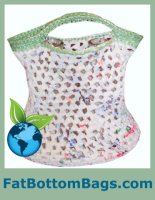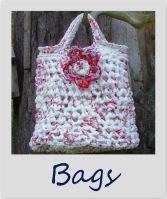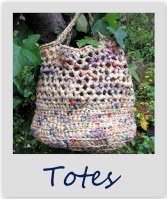The tablet contains a complete hymn, both words and music, in addition to detailed performance instructions for a singer accompanied by a harpist as well as instructions on how to tune the harp.
art
Sound of music … circa 3400 BC
Changent Paul Young
TED Tuesday: Exposing invisible
Recycle craft: RetroGrandma Audrey
TED Tuesday: Tiding up art
Recyle craft: Fat Bottom Bags
Guest post generously contributed by Recycle crafter Christi Spangler of FatBottomBags.com (Facebook, Twitter).
Hi everyone! First off, I’m so honored to be guest posting today on Watchful Eyes Thoughtful Mind. Thanks for the invite Radiance!
My name is Christi Spangler and I’m an evironmentally concious recycle crafter and founder of FatBottomBags.com a plastic bag recycling project.
FatBottomBags.com was born from my dream of a better world and my desire to find a way to repurpose those problematic plastic carrier bags. My goal was to find some way to utilize this wasted resource while raising awareness about the importance of recycling and the harm that these bags and other plastic debris is doing to our environment.
A few years ago I began making these reusable bags from “disposables” and selling them locally. After talking with many other concerned people in my area, I was encouraged to bring the message and these great bags to the internet in order to reach out globally. So here I am!
I quickly recycled through all of the bags I had collected on my own, so I put the call out to friends, family and other locals to gather up and recycle the plastic bags they might have stashed in drawers and closets. Now I’m up to 23 families for whom I recycle on a regular basis. In addition to the locals, I’ve started a couple of recycling exchanges online. Through the website, I’m collecting colored plastic bags and mesh produce bags for recycling too!
So far at FatBottomBags.com our efforts have kept over 5000 (and counting) plastic bags from becoming part of the problem in our wastestream. And that’s just what I’ve recycled from my kitchen table! In addition, I’m encouraging others to take an active role in recycling too! I’ve shared my secret with a DIY video to make your own mesh sided FatBottomBag and I’m blogging about other ways you can make a difference too!
ingesting plastic bags.
9 types of intelligence
Related articles by Zemanta
- What Does a Smart Brain Look Like?: Inner Views Show How We Think (scientificamerican.com)
- Intelligence Explained (technologyreview.com)
- Can Exercise Boost Your Brainpower? (abcnews.go.com)
TED Tuesday: Origami using maths
Related articles by Zemanta
- 10 Amazingly Geeky Origami Models (neatorama.com)
TED Tuesday: Art that looks back at you
Related articles by Zemanta
- The Intersection of Art and Technology (takepart.com)
Sci-tech goes arty
How does it glow?
Multiple colors of fluorescent protein, introduced into its DNA (2008)
What can we learn?
One of the team of scientists that won a 2008 Nobel Prize for green fluorescent protein—Osamu Shimomura, Martin Chalfie, and Roger Y. Tsien–couldn’t resist showing off their creation a bit. From Tsien’s lab comes this artful plate with selectively swabbed fluorescent bacteria. The discovery of green fluorescent protein by Shimomura in 1956 was the result of crushing countless jellyfish. After publishing his findings in 1962, Shimomura studied GFP in detail and realized that no extra fuel was needed to make it glow–other glowing substances need chemical additives to shine. GFP, by contrast, just needed to be exposed to ultraviolet light.Chalfie, the third of the GFP Nobel winners, realized the maintenance-free protein could be used to literally watch how creatures work. He proved with the intestinal bacterium E.
coli that GFP alone–with no fuel–glowed, and promptly started putting it into roundworms.Roger Tsien kicked it up a notch by reengineering GFP to be cyan, blue, and yellow. Yet more colors were found in fluorescent coral. He remixed these materials into glowing proteins such as “mPlum,” “mStrawberry,” and “mOrange.”Though their inventions may have revolutionized the fields of medicine, biology, and chemistry, the fluorescent proteins also have creative applications, as shown above. Fluorescent proteins have also been used in the name of art to make sculptures out of glowing beakers and live glowing rabbits.
— Photograph courtesy UC San Diego via AP
Related articles by Zemanta
- Fluorescent GM monkeys ‘could help find Parkinson’s cure’ (telegraph.co.uk)
- Glowing Animals (neatorama.com)
- A Conversation With Martin Chalfie: Watching Life in Real Time (nytimes.com)












![Reblog this post [with Zemanta]](https://i0.wp.com/img.zemanta.com/reblog_e.png)


